#Patanjali’s teachings
Explore tagged Tumblr posts
Text
Post 3: Discovering the True Self: Reflections on Patanjali’s Sutras 1.3 and 1.4
In the previous post, we explored the importance of discipline and of calming the mind’s fluctuations, or vrittis, as described in Sutra 1.2. This brings us to the next essential question: What happens when the mind becomes still? What is revealed in that stillness, and what occurs when we remain caught in the waves of thought? Patanjali’s Sutras 1.3 and 1.4 address these questions…
#calming the mind#cultivating awareness#illusion and reality#Inner peace#Inner stillness#journey to self-awareness#Meditation practice#Mind Fluctuations#Patanjali Sutra 1.3#Patanjali Sutra 1.4#Patanjali’s teachings#perception versus misperception#Raja Yoga#Self-awareness#Self-Realization#Spiritual Clarity#spiritual growth#Swami Vivekananda translation#understanding the true self#Vrittis#yoga for mental clarity#yoga philosophy for beginners#Yoga Sutras of Patanjali#yogic discipline#yogic insights#yogic philosophy#yogic wisdom
0 notes
Text

Mahakali Talon Abraxas
The Goddess Kali and the Spiritual Heart
Ma Kali and the Yoga of Knowledge
Ma Kali is the primary Goddess of Yoga, the background Yoga Shakti, the power of Yoga or Kriya Shakti. Hers is the force that takes our energy within, which causes us to seek the eternal and lose interest in the outer affairs of life. She is the electrical stirring of the soul to Divinity. She is the voice of the Divine reverberating within us, when we let our ego fade into the background. Kali is the power of the great current of awareness.
Kali is the great Prana or cosmic life-force (Mahaprana). She represents the most primal will of all life, which is to live forever and never die. This core wish for immortality is not some mere delusion or arrogance within us, it is the very reflection of Sat or pure Being into creation, the portion of the Eternal that is our soul.
Kali represents the most primal desire, which is to love all and be one with all, to find the perfect, pure and eternal bliss, which is the presence of Shiva, the Eternal Being and Consciousness hidden in all life. Hidden even in ordinary desires is Kali’s ascending force to get us to seek something more beautiful and wondrous, to take us beyond our boundaries, to make us unhappy with what we already have in order to reach a greater reality.
Her will-power generates the decisive moment of spiritual awakening, in which we realize that true happiness cannot be found in the outer world but only within. Then she redirects our life as a mystic journey to the inner source, the heart of creation, and the Eternal flame.
Kali’s Shakti works to focus our energies back to the heart and the core of our being. Kali’s energy reverses the ordinary process of creation. Hers is the power that merges earth into water, water into fire, fire into air, air into ether, ether into mind, and mind into pure consciousness. She takes us back from the many to the One, reintegrating the world into our deepest Self and Being.
Ma Kali’s energy is like a simulated death experience. She helps us withdraw our attention from the outer mind, emotions and senses into the inner heart. In this regard, Kali is the prime Goddess of Jnana or Self-knowledge. She takes us back to the Self in the heart, unifying all our experience within it. Kali is Nirvana Shakti, the power that takes us to dissolution or Nirvana. She is the magnetic pull of Nirvana within us.
In Yogic terms, Kali is the Nirodha Shakti, the power that gives the ability to dissolve the fluctuations of the mind stuff or chitta, that is the tradition definition of Yoga through Patanjali in the Yoga Sutras. Her power checks, negates, masters and dissolves all the functions of mind and prana into the infinite silent calm of the Purusha within the heart.
One is reminded of the experience of Paramahansa Ramakrishna, who was a great devotee of Kali. After learning the importance of the Self-knowledge of Vedanta through his guru Tota Puri, Ramakrishna meditated on the Self within the heart in order to realize it. In doing so, the image of Ma Kali arose. He found that he had to break through his attachment to her by removing her form with the sword of knowledge. Yet he had to eventually realize that the sword of knowledge was that of Ma Kali. She projects a form to teach us, but removes the form to reveal her formless being as Pure Consciousness.
The Power of Ma Kali’s Mantras
Ma Kali’s Bija Krim
Each deity has its mantras, starting with single-syllable seed or bija mantras and extending to longer mantras, prayers and supplications. Kali’s primary single syllable mantra is KRIM (pronounced Kreem). KRIM refers to Kriya or the power of action, but action of a yogic nature.
KRIM is composed of three primary letters. The letter-k is the first of all the consonants in the Sanskrit alphabet. It indicates manifest existence, power and force. The letter-r is the seed of fire and light. The letter-i is focused energy and will power.
KRIM as the sound of Kali sets in motion the primary force of life and manifestation. It is the electrical energy or lightning force that gives power to everything, like the electric current that can run any number of appliances.
Yet when we use this mantra in sadhana or yogic practices, it is the inner current that we are switching on. Once this inner current is available we can use it to empower any sadhana or open up any inner faculty, just like having the electricity on in our house can allow us to do so many things and without it we can do nothing.
The great Goddess Kali, specifically through her mantra KRIM, provides us the support of energy for all that we do in Yoga. More so, she increases our inner energy, both allowing and pushing us on to do more. Her mantra creates a relentless force of spiritual energy within us that does not merely help us but propels and guides us to the higher goal. At some point her current takes over from our minds and directs our sadhana by its flow. This opens up the higher level of working with her power and her presence. Kali’s Kriya Shakti allows the Yoga to work but also as an ascending lightning force can break through all obstacles and veils of karma, prana or mind.
The mantra KRIM also has a fierce side, like a jolt of lightning it can function like a sword to cut things open. It can stimulate, shock, electrify and propel. It can energize the weapons of the Gods to defeat the undivine or Asuric forces. Yet it can energize the ornaments of the Gods, their gems and gifts, which grant bliss to the devotee.
Kali’s Threefold Bija: KRIM HUM HRIM
Out of this single seed mantra is developed a longer threefold mantra or three seed-mantras as KRIM HUM HRIM. This has yet more energy and efficacy in awakening the Goddess within us. It begins with the mantra KRIM and builds upon its power.
The mantra HUM (hoom) is composed of two primary sounds. The letter-h is the seed syllable of the element of space or ether. It also represents the sun, Prana and the Purusha principle. The letter-u creates a force field that can both serve to hold in and to push out. HUM represents an explosion of energy, an expression of great power that is pranic, electrical and fiery. HUM is the power of Agni or fire particularly as directed by the wind or Vayu. Whereas KRIM awakens the electrical force or Shakti, HUM serves to direct it with great force, to use it to make great efforts.
HRIM (hreem) is the great mantra of the spiritual heart, hridaya. It is composed of three main letters. The letter-h, as in HUM, represents, space, prana and light. The letter-r as in KRIM represents light and fire. The letter-i as in KRIM represents focused energy or a ray of light, the Shakti as such. Through the mantra HRIM alone one can enter into the spiritual heart and the small space within its lotus (dahara akasha) in which the entire universe is held.
These put together, Kali’s threefold mantra serves to awaken and energize the spiritual heart, hridaya.
The mantra KRIM serves to cut the knots of the heart. It works like a sword. It stimulates the heart energy within us, its primal desire or wish for immortality, love and light.
The mantra HUM gives power to the heart, expanding the energy of prana and Agni (fire) in a strong, if not explosive manner.
The mantra HRIM opens the energy of the spiritual heart which is like the Sun, spreading it into the Infinite.
This threefold Kali Heart mantra can be compared to a kind of spiritual adrenaline. KRIM awakens the energy of the heart, like an electrical jolt to a heart patient whose heart is failing. HUM expands it this current with great force. HRIM stabilizes it as an infinite power and eternal presence.
KRIM draws the Prana from the breath, the sensory and motor organs and directs it into the heart. HUM turns the Prana into a force of fiery meditative power. HRIM connects the individual prana-mind with the power of the Supreme Self, the power of the light of consciousness (Chid-jyoti). This threefold mantra therefore creates a powerful Pratyahara in the yogic sense, it takes our energy back to the spiritual heart.
Kali Sadhana and the Yoga of Knowledge
Kali mantras serve to develop a Kali Sadhana, in which the true nature of Kali is revealed. In this regard, Kali is the death of the ego, which is the rebirth of the soul. Kali is the Divine Mother in her role of slaying the demon or dragon of the ego or I am the body idea. Her mantras bring about an inner death, which is the rebirth of the immortal Self within us.
Through Kali we can experience a simulated death, the real death which is that of the ego, after which there is no more death. Kali is this death of death by the power of eternity. Kali mantras take us into the spiritual heart. They are a good accompaniment to Atma Vichara.
The Goddess Kali, we might say, is the power of meditation personified as a Goddess. Yet She is meditation not as a mere technique, She is the natural state of meditation as the power of consciousness pervading Infinite Space and Eternal Time, in which the waves of karma, including birth and death, cannot touch us, because we are the All!
32 notes
·
View notes
Text
Happy International Yoga Day!

Today we celebrate the ancient practice of yoga, which has been a cornerstone of Indian culture for over 5,000 years. We honor the "Father of Modern Yoga," Tirumalai Krishnamacharya (1888-1989), who played a crucial role in popularizing yoga worldwide. We also honor the original "Father of Yoga," Patanjali, who authored the celebrated yoga sutras.
_History of Yoga:_
Yoga has its roots in the Indus Valley Civilization, with evidence of yoga practices dating back to 3000 BCE. The word "yoga" comes from the Sanskrit word "yuj" meaning "to unite." Over time, yoga evolved through various traditions, including Hatha Yoga, Raja Yoga, and Bhakti Yoga.
Patanjali:
Patanjali was a Hindu author, mystic, and philosopher who authored the Yoga Sutras, a categorization of yogic thought arranged in four volumes. He is regarded as an avatar of Adi Sesha and is believed to have lived between the 2nd century BCE and the 5th century CE ¹.
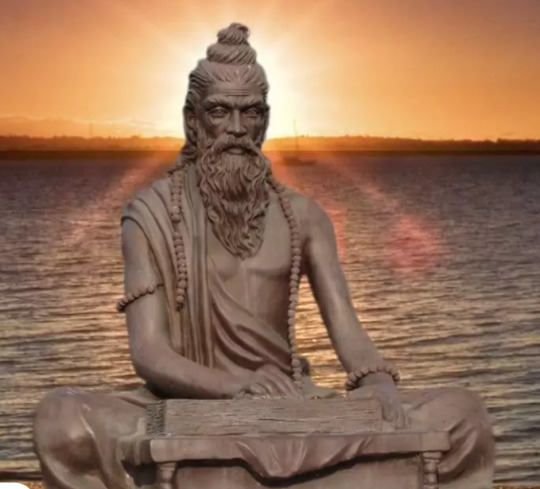
Tirumalai Krishnamacharya:
Born in 1888, Krishnamacharya was a Indian yoga master, ayurvedic healer, and scholar. He studied yoga under his father and later under the revered yoga guru, Rama Mohan Brahmachari. Krishnamacharya went on to teach yoga to prominent students, including B.K.S. Iyengar, K. Pattabhi Jois, and Indra Devi, who spread yoga globally.
BENEFITS OF YOGA
Yoga offers numerous benefits, including:
- Improved flexibility and strength
- Reduced stress and anxiety
- Enhanced mental clarity and focus
- Improved overall well-being
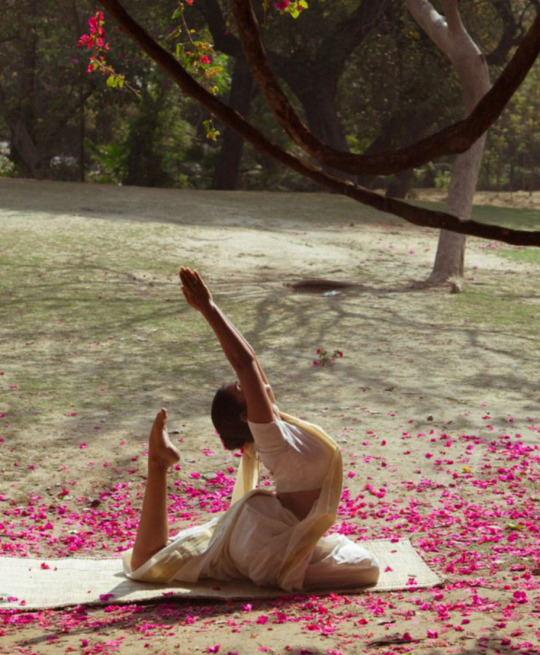
Popular Yoga Asanas:
1. Downward-Facing Dog (Adho Mukha Svanasana)
2. Warrior Pose (Virabhadrasana)
3. Triangle Pose (Trikonasana)
4. Seated Forward Fold (Paschimottanasana)
5. Tree Pose (Vrksasana)
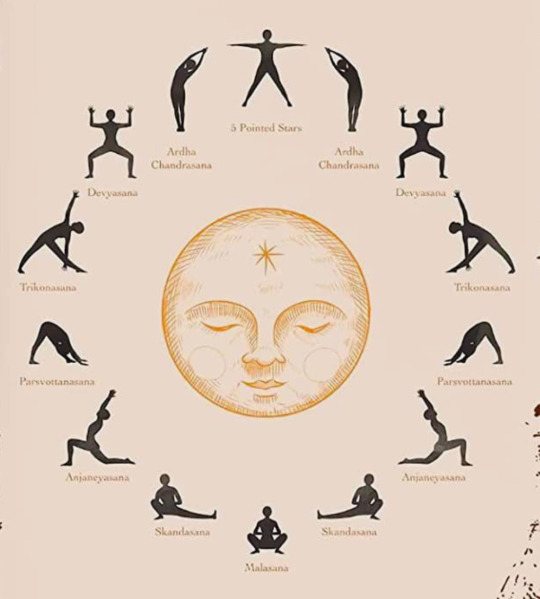
#InternationalYogaDay#YogaForAll#desiblr#desi tumblr#desi girl#being desi#desi tag#desi aesthetic#yoga#indian culture#health and wellness#desi#international yoga day#hinduism#hindublr
45 notes
·
View notes
Text

The particular beauty of this scripture, The Voice of the Silence, is that it is practical. It teaches a very profound mystical science of acquiring information for ourselves, not merely with the senses of our physical experience, but with the consciousness. Some people have called that consciousness soul: the ability to perceive and to understand.
In our last lecture, we talked about the stages of meditation, the principles outlined such as in the Yoga Sutras of Patanjali, which are also correlated within Buddhism, as well as Blavatsky’s scriptures, or her translation of it.
More importantly, what we want to understand in this talk today is the spiritual path known as initiation. It is a path in which by meditating, the consciousness develops its true potential and is able to understand mysteries beyond the senses, beyond physical experience, and beyond our common daily life.
New Lecture Transcription!
#gnosis#gnostic#gnostics#gnostic tradition#gnostic teachings#gnostical#gnosticism#chicago gnosis podcast#chicagognosis#gnostic academy of chicago#chicago gnosis#blavatsky#spirituality#consciousness#awakening#meditation#samael aun weor#theosophy#voice of the silence#esotericknowledge#esoteric knowledge#esoterism#esotericism#esoteric#esoteric christianity#esoterist#spiritual#spiritual enlightenment#spiritual path#spiritual initiation
14 notes
·
View notes
Text
The Yamas and Niyamas are ethical and moral guidelines
The Yamas and Niyamas are ethical and moral guidelines outlined in the ancient yogic philosophy of Patanjali's Yoga Sutras. They offer principles for living a harmonious and fulfilling life. Here are the benefits associated with practicing the Yamas and Niyamas:
Yamas:
Ahimsa (Non-violence): Practicing ahimsa promotes peace and compassion. It encourages individuals to cultivate kindness towards themselves and others, leading to improved relationships and a more harmonious society.
Satya (Truthfulness): Living truthfully fosters authenticity and integrity. Being honest with oneself and others builds trust and strengthens connections, resulting in healthier relationships and a sense of inner peace.
Asteya (Non-stealing): By practicing asteya, individuals learn contentment and gratitude for what they have. This cultivates a mindset of abundance rather than scarcity, promoting generosity and reducing feelings of envy or lack.
Brahmacharya (Moderation): Brahmacharya encourages balanced living and mindful consumption. By practicing moderation in all aspects of life, individuals conserve energy, maintain focus, and cultivate self-discipline, leading to greater physical, mental, and emotional well-being.
Aparigraha (Non-attachment): Aparigraha teaches the art of letting go and releasing attachments to outcomes. By detaching from material possessions, expectations, and desires, individuals experience freedom from stress, anxiety, and dissatisfaction, leading to greater contentment and inner peace.
Niyamas:
Saucha (Purity/Cleanliness): Practicing saucha involves purifying the body, mind, and environment. This fosters clarity of thought, enhances physical health, and creates a conducive space for spiritual growth and self-discovery.
Santosha (Contentment): Santosha promotes gratitude and acceptance of the present moment. Cultivating contentment regardless of external circumstances leads to greater peace of mind, reduced stress, and an increased sense of fulfillment.
Tapas (Discipline): Tapas involves cultivating self-discipline and perseverance in pursuit of spiritual growth and personal development. By embracing challenges and overcoming obstacles, individuals build resilience, inner strength, and a sense of accomplishment.
Svadhyaya (Self-study): Svadhyaya encourages self-reflection and introspection. By studying sacred texts, exploring personal beliefs, and observing one's thoughts and actions, individuals gain insight into themselves, deepen their understanding of life's mysteries, and foster spiritual evolution.
Ishvara Pranidhana (Surrender to the Divine): Ishvara Pranidhana involves surrendering to a higher power or divine intelligence. By relinquishing the ego's need for control and trusting in a greater purpose, individuals find peace, guidance, and spiritual connection.
Overall, practicing the Yamas and Niyamas promotes personal growth, ethical behavior, and spiritual development. By aligning one's actions with these principles, individuals cultivate virtues such as compassion, truthfulness, contentment, and self-discipline, leading to a more fulfilling and meaningful life.
#astrology numerology vedicastrology#vedic astrology#vedas#vedic jyotish online#astrology#vedic astro observations#lordkrishna#krishna#harekrishna#hare krishna#vedic culture#veda#vedanta
28 notes
·
View notes
Text
A Short Introduction to the Yoga Sutras
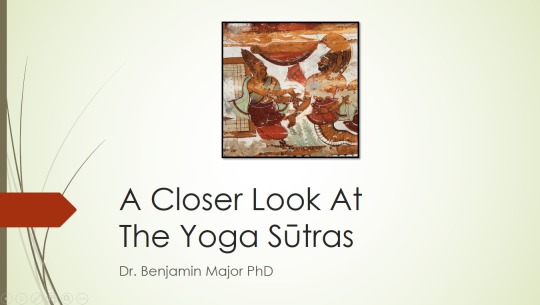
The Yoga Sutras are generally considered a foundational text of the yoga tradition. In this article we examine the context and background of the text, briefly explore its structure and content, and I also offer some reflections on the text’s relevance in modern times.
Note: I have decided not to use diacritics in this article. Diacritics are those little lines and dots above and below letters that tell you how to pronounce Sanskrit words. Normally I use diacritics in my writing, as they are essential for pronouncing Sanskrit correctly. However as this article is meant for non-scholars I have decided it would be better to try and write the Sanskrit words in a way that will make them easy to read and pronounce, so as not to put anybody off!
History & Context
Most scholars these days date the Yoga Sutras to somewhere between the 2nd and 5th centuries CE, with Philipp Maas placing it in the early 5th century.
The text is attributed to a sage named Patanjali. Biographically, we know next to nothing about Patanjali. The name is a compound word formed from the Sanskrit words pata (falling, flying) and anjali (the gesture of joining the hands together in reverence).
Yoga had already been around in some form or another for many centuries by this point. Therefore, Patanjali did not ‘invent’ Yoga. Nevertheless, this is the earliest comprehensive and systematic text on the subject that has survived.
Yoga was just one darshana or school out of many in ancient India. In terms of philosophy, it shares many similarities with the Samkhya school. But whereas Samkhya tends to emphasise the use of reason and knowledge to gain liberation, Yoga emphasises practical and experiential methods.
Philosophically, both the Samkhya and Yoga schools teach a form of dualism. This is a dualism between purusha (our true Self) and prakriti (everything else, including the body and mind) and the whole point of Samkhya and Yoga in a nutshell is to guide us towards the realisation of purusha, that is, our true Self. This is true liberation or moksha in Yoga.
Most of the ancient darshanas had their own sutra text. Sutra texts are known for their brevity. Basically, sutra texts are where the most essential teachings of a school are distilled into as few words as possible. Knowledge systems were handed down orally in ancient India and thus source material was kept minimal with a view to facilitating memorisation.
Other authors would then come along and write longer commentaries on these sutra texts. The Yoga Sutras have a rich commentarial tradition spanning many centuries. The first and most well known is the bhasya commentary by a certain Vyasa. Vyasa actually means something like ‘compiler’ or ‘editor’ so that probably wasn’t his actual name!
Some scholars even argue that Patanjali and Vyasa are actually one and the same person, though others would strongly disagree with this thesis. Either way, this commentary is indispensable when it comes to making sense of the sutras, and published versions of the Yoga Sutras tend to include the bhasya commentary or at least reference it.
As a final note, many scholars now use the term pātañjalayogaśāstra to refer to this text as a whole (sutras plus commentary), because that is the name our oldest existing manuscripts use. But to keep things simple we will continue to use the name Yoga Sutras!
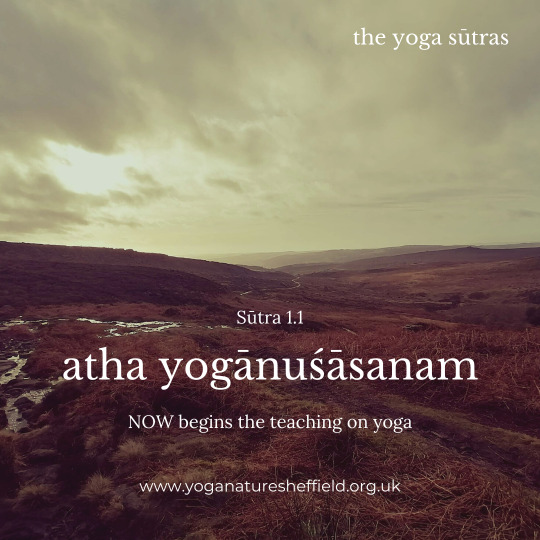
Structure of the Text
The Yoga Sutras are divided into the following four padas or chapters:
Samadhi Pada: This is where Patanjali defines Yoga and then describes the nature and the means to samadhi, the goal of Yoga.
Sadhana Pada: Sadhana is the Sanskrit word for practice or discipline. Here the author outlines two forms of Yoga, the kriya yoga (yoga of action) and the ashtanga yoga (the yoga of eight auxiliaries or limbs). This is also where Patanjali discusses the kleshas, five ‘afflictions’ or impediments to Yoga.
Vibhuti Pada: Vibhuti is the Sanskrit word for power or manifestation. Supra-normal powers (siddhis) are said to be acquired by the practice of Yoga. However, the temptation of these powers should be avoided and the attention should ultimately be fixed only on liberation.
Kaivalya Pada: Kaivalya literally means isolation. This is the chapter on final liberation. The Kaivalya Pada describes the process of liberation, it explains how the mind is constructed and veils the inner light of the Self.
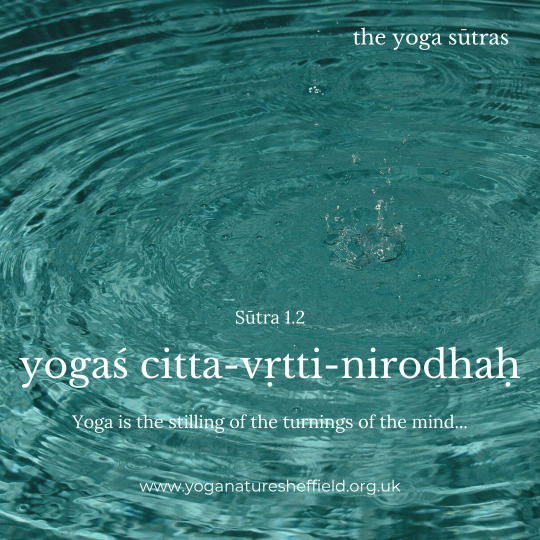
The Goal of Yoga
Not one for a lengthy preamble, Patanjali gets stuck right in there and clearly states the goal of Yoga in the well-known second sutra:
yogas chitta-vritti-nirodhah YS 1.2
Any Sanskrit sentence allows for a number of possible translations and this one is no different. A nice and accurate one is this one from Barbara Stoler Miller:
Yoga is the cessation of the turnings of thought
The reason I say this one is accurate is because a literal meaning of vritti is ‘turning’. Ever felt that thoughts are ‘going round and round’ in your head? Well this phrase nicely captures that! The vrittis in this statement refer to thoughts, emotions, ideas and basically any cognitive act of the mind. Patanjali lists five types of vrittis. These are, once translated:
Right knowledge
Error or false knowledge
Imagination
Sleep &
Memory
All such activities of the mind are products of prakriti and are completely distinct from the true Self, purusha, that pure awareness or consciousness which we are aiming to enter into through Yoga. The means prescribed by Patanjali in the first chapter of the Yoga Sutras to still the vritti states of mind are sustained practice (abhyasa) and dispassion (vairagya).
Specifically the practice offered is meditation, or keeping the mind fixed on any particular object of choice without distraction. Patanjali then describes a number of possible forms such meditation could take. By stilling all thought, meditation removes all objects of awareness. Awareness can therefore now be aware only of itself, of its own source, the true Self or purusha. This state is known as samadhi in Yoga and Patanjali makes it super clear that this state of samadhi is the goal of Yoga and thus the whole text is focused upon achievement of that goal.
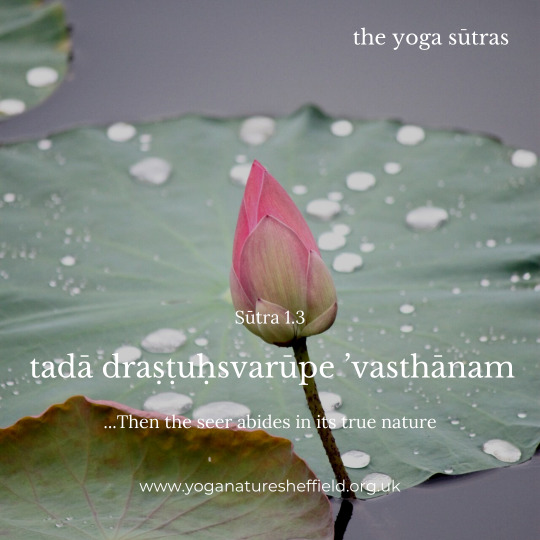
Obstacles to Yoga
Patanjali mentions five kleshas, which can be translated as impediments or obstacles to achieving samadhi and thus Yoga. These five are as follows:
Ignorance
Ego
Desire
Aversion
Clinging
In the Yoga Sutras, and indeed in ancient Indian philosophy in general, the first item in any list is the most important and fundamental. It’s the same here. Ignorance here means failing to recognise our true Self or purusha and instead identifying ourselves with our body, mind and the material world. All of the other obstacles arise from this fundamental error.
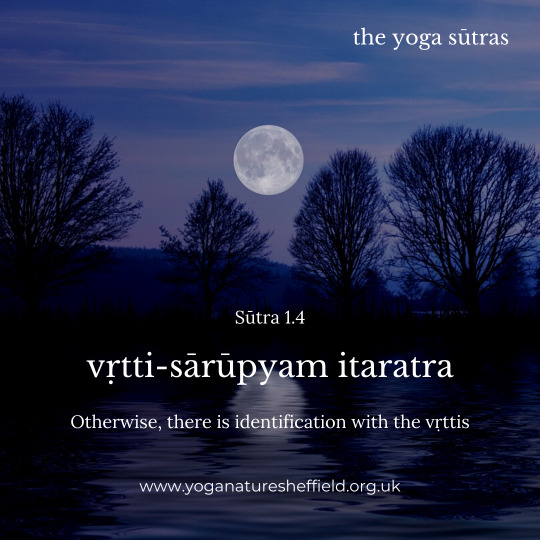
Yoga Psychology
Like most other schools of Indian thought, the Yoga school believed in the related concepts of karma and rebirth. According to this doctrine, we are caught in an endless cycle of rebirths called samsara and the purpose of following a path such as Jainism, Buddhism or Yoga is to bring an end to this cycle. Where the Yoga Sutras really shine are in interpreting this doctrine in a highly sophisticated ‘psychological’ way, to use modern terminology.
According to this Yoga psychology, the mind forms an impression of an object through the sense organs, which is called a pratyaya. Once this pratyaya or active image of this object is no longer of active interest to the mind, it becomes an inactive or latent samskara. A samskara is an imprint left in the chitta, somewhat like a sound is imprinted on a tape recorder, or an image on photographic film. In this way the vrittis, the activities of the mind, are retained as samskaras when they fade.
It is important to note that these samskaras are not just passive imprints but vibrant latent impulses that can get activated under conducive circumstances and can exert influence on a person’s thoughts and behaviours, even many years after the impression was made. What’s more, according to Yoga these samskaras can persist from previous lives. The chitta is thus something of a storehouse of these recorded samskaras, deposited and accumulated there over countless lifetimes. One is here reminded of the theory of the subconscious in modern psychoanalysis.
According to Yoga, karma is generated by the vrittis, and the vrittis, in turn, are produced by the kleshas. There is thus a vicious cycle of kleshas, vrittis and samskaras. To run through the whole cycle again to try and make it as clear as possible: vrittis are recorded in the chitta as samskaras, and these samskaras eventually activate consciously or subliminally, producing further vrittis. These vrittis then provoke actions and reactions, which in turn are recorded as samskaras, and the cycle continues endlessly, leading to much suffering along the way.
The whole Yoga project aims to bring this vicious cycle to an end and it is liberation from this mind created suffering that we are after as yogis. The Yoga Sutras are effectively a manual guiding us towards this end, this state of samadhi or complete meditative consciousness.

The Yamas and Niyamas
The second pada or chapter of the Yoga Sutras contains a famous exposition of five ethical restraints (yamas) and five ethical observances (niyamas) and these are relatively well-known in the modern yoga world. The first thing to get clear is that these yamas and niyamas are NOT original or unique to Yoga. All ascetic schools in ancient India had these ethical codes, and the exact same ones appear in Jainism for example. Sometimes, you even get more of them. Some yoga texts for instance list 10 yamas and 10 niyamas.
The five yamas listed in the Yoga Sutras are:
Ahimsa (non-harming) Satya (truth telling) Asteya (non-stealing) Brahmacharya (chastity or celibacy) Aparigraha (non-acquisitiveness)
The five niyamas are:
Shauca (purity or cleanliness) Santosha (contentment) Tapas (self-discipline) Svadhyaya (study) Ishvarapranidhana (devotion to the Ishvara or Lord)
Many of these could do with further explanation and commentary but there is not space in this present article. The other thing I want to stress is that these yamas and niyamas were not seen as optional extras for yogis. Rather, these were the bedrock of fruitful yoga practice. Patanjali and others refer to them as the mahavratam or ‘great vow’. Importantly, having listed the yamas, Patanjali devotes an entire sutra to reiterating just how central and non-negotiable these yamas are. Once translated, this sutra reads as follows:
[These yamas] are considered the great vow. They are not exempted by one’s class, place, time or circumstance. They are universal. YS 2.31
So, regardless of your social status, regardless of where you live, in which time period you live, and any other extenuating circumstances (such as your career), adherence to the yamas, including especially ahimsa, the foundation of them all, is an essential part of being a yogi as defined by Patanjali’s system.
Vyasa is even more emphatic in his bhasya commentary to the Yoga Sutras, and it is here that the link between ahimsa and vegetarianism is explicitly and unequivocally made, and several examples are brought to bear. Refer to the work of scholar Jonathan Dickstein to read more about the strong case for vegetarianism made in Patanjali Yoga.
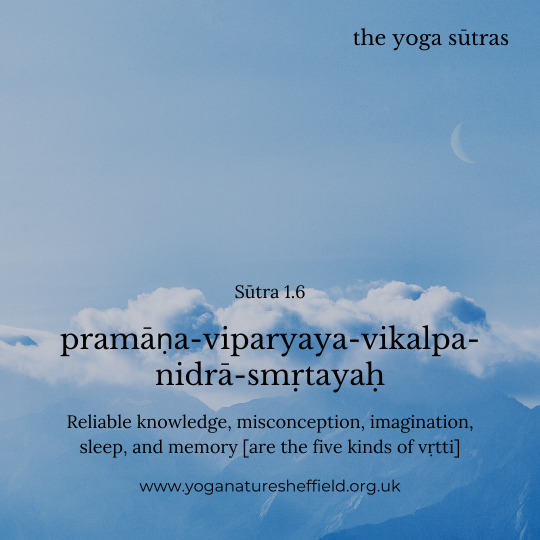
The Ashtanga Yoga
These yamas and niyamas are just the first two parts of Patanjali’s famous ashtanga or eight-part path. I would first like to clarify that this systematisation of yoga into a series of angas (a word translated by some modern scholars as ‘auxiliaries’ but more commonly rendered as ‘limbs’) was again not novel to Patanjali. Throughout the yoga tradition we find various similar schemes, predating and postdating Patanjali, including fourfold, fivefold, sevenfold and even fifteenfold schemes. I would also like to stress that, despite sharing the same name, this ashtanga yoga bears little relation to the modern postural form of yoga known as Ashtanga.
Following the yamas and niyamas then, we then have the following six angas:
Asana (posture): At last I hear you cry, postures! In Patanjali’s day meaning a steady and comfortable seated posture, asanas today comprise a set of physical exercises which stretch and strengthen the body. It is this aspect of yoga that has been most visibly exported to the West but too often stripped from its context as just one ingredient in a more ambitious and far-reaching sequence.
Pranayama (breath control): Prana refers to the universal life force whilst ayama means to regulate or control, but it can also mean to expand and lengthen. Prana is the vital energy needed by our physical and subtle layers, without which the body would perish. It is what keeps us alive. Pranayama is thus the control or expansion of prana through the breath, depending on which definition of ayama you use.
Pratyahara (withdrawal of the senses): This limb further deepens the above process by removing consciousness from all engagement with the senses (sight, sound, taste, smell and touch) and sense objects.
This is followed by the final three limbs collectively known as samyama: Dharana (concentration, fixation), Dhyana (meditation), and finally Samadhi (the latter of which Patanjali further divides into seven rather esoteric stages). These last three limbs are essentially different degrees of concentrative intensity and culminate in the realisation by the Self of its own nature.
Just to reiterate one more time, it is this Self-realisation, the state known as samadhi, that is the true goal of Yoga.
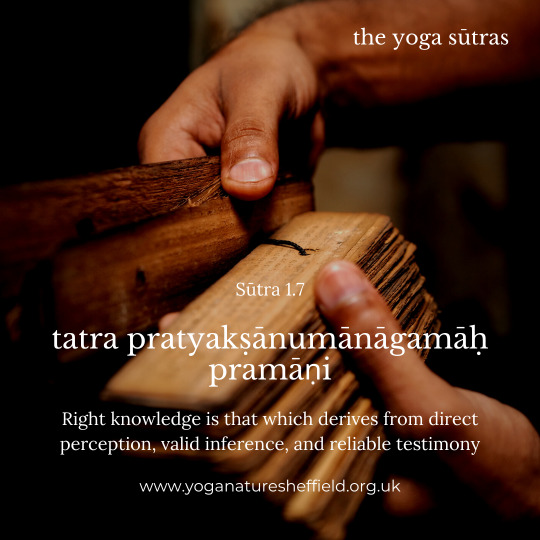
Relevance of the Yoga Sutras for Today
In this brief introduction we have of course only scratched the surface of this incredible text, and there is much more that could be said. But for now I want to end with some concluding reflections on the continuing relevance of the Yoga Sutras in the modern world.
One question that arises is whether Patanjali was prescribing a strictly ascetic path. And indeed, the general scholarly consensus has usually been to associate Patanjali's Yoga exclusively with extreme asceticism, mortification, denial and renunciation. However, there are dissenting vocies. For example, Ian Whicher has repeatedly and passionately argued that Patanjali's Yoga can be seen as enabling a more responsible living in and engagement with the world, and that Patanjali was not advocating total renunciation. For Whicher, following the path of Patanjali can lead one towards that integrated and embodied state of liberated selfhood whilst living, a state known as jivanmukti.
Regardless of whether Patanjali was historically preaching ascetism or not, the fact remains that the Yoga Sutras are full of valuable ideals and tools for the practitioner living in the modern world. Let’s face it though, this is a challenging path. As a scholar and practitioner I often perceive a huge disconnect between the kind of yoga I am seeing on the likes of Instagram and the teachings of the Yoga school as presented in the Yoga Sutras. After, all, the former is highly focused on body image, whereas the Yoga of Patanjali is all about dissociating ourselves from our body and mind and recognising our true Self. However, this does not mean that the two are necessarily irreconcilable.
Though there is absolutely no historical evidence that Patanjali and his followers were practicing postural yoga (that didn’t come until later with the emergence of the Hatha tradition) nowhere in the Yoga Sutras does it say that physical exercise cannot be part of one’s yoga practice. We just have to remember that as far as Patanjalian Yoga is concerned, such postural activity is just a further means or method on the path towards samadhi or full meditative awareness. This is why any so-called yoga that does not contain more internalised meditational practices but which focuses solely on physical exercise should not really be called yoga.
The Yoga Sutras remains undoubtedly the most famous ancient yoga text, and it is studied to some extent in probably every yoga teacher training course. To be honest, I personally feel that too much emphasis is placed on the Yoga Sutras, at the expense of other branches and other texts of the tradition. The Tantric texts, in particular, are still sorely neglected. One of my own aims in my work is to try and decentre the Yoga Sutras and provide a much wider overview of the history and philosophy of yoga and the other related schools of ancient India. This is not to take anything away from the Yoga Sutras, however, as it is without doubt an extraordinary text that continues to be highly relevant in the 21st century.
Further Reading
I have already mentioned some scholars whose work you may wish to refer to, such as Philipp André Maas, Ian Whicher and Barbara Stoler Miller. For a translation and commentary on the Yoga Sutras that is both scholarly accurate and reasonably accessible I would recommend that of Edwin Bryant published by North Point Press.
11 notes
·
View notes
Text
VedaVerse: Best Yoga Teacher Training In India
VedaVerse is the best yoga school in rishikesh, India, registered with Yoga Alliance & 200 and 300 Hour Hatha Yoga Teacher Training in India. Enquire Now!
Why Choose India for Yoga Teacher Training?
India is where yoga originated over 5,000 years ago, and it remains the spiritual hub for practitioners worldwide. Training in India allows you to immerse yourself in the ancient teachings of yoga, (Yoga Teacher Training india) guided by gurus and masters who have dedicated their lives to this sacred discipline.
Cultural and Spiritual Immersion
Indian yoga schools often integrate traditional practices, including pranayama (breathing techniques), meditation, and chanting, creating a holistic approach to learning.
Authenticity and Expertise
Indian yoga teacher training programs prioritize authenticity. Most schools follow the guidelines of Yoga Alliance, ensuring internationally recognized certifications.
Hatha Yoga Teacher Training in India
Hatha Yoga is one of the most popular yoga disciplines, focusing on physical postures (asanas) and breathing techniques (pranayama) to balance the mind and body. Many schools in India specialize in Hatha Yoga, making it the perfect starting point for aspiring teachers.
Key Components of Hatha Yoga Training
Asanas (Postures): Learn the foundational poses that form the core of yoga practice.
Pranayama (Breath Control): Master breathing techniques to enhance energy flow.
Meditation: Develop mindfulness and spiritual awareness.
Yoga Philosophy: Study the ancient texts like Patanjali’s Yoga Sutras and the Bhagavad Gita.
Teaching Methodology: Gain the skills to teach and adapt yoga classes for diverse groups.
Best Locations for Hatha Yoga Teacher Training
Rishikesh: Known as the "Yoga Capital of the World," Rishikesh offers a serene environment alongside the sacred Ganges River.
Kerala: Combine yoga with Ayurveda in this tranquil southern state.
Mysore: Famous for Ashtanga and Hatha Yoga, Mysore provides an enriching learning experience.
Top Yoga Courses in India
India offers a plethora of courses tailored to meet the diverse needs of yoga enthusiasts. Here are the top programs to consider:
200-Hour Yoga Teacher Training
Ideal for beginners, this course covers fundamental asanas, pranayama, meditation, and anatomy. After completion, participants are certified as RYT-200 (Registered Yoga Teacher).
300-Hour Advanced Yoga Teacher Training
Designed for those with prior experience, this program delves deeper into advanced postures, yoga therapy, and teaching methodologies.
500-Hour Comprehensive Training
A combination of the 200-hour and 300-hour courses, this rigorous program offers an all-encompassing understanding of yoga and its practices.
Choosing the Right Yoga School in India
Selecting the right school is crucial for a fulfilling YTT experience. Look for:
Accreditation: Ensure the school is registered with Yoga Alliance.
Experienced Teachers: Check the credentials and teaching experience of the faculty.
Curriculum: Opt for a program that aligns with your goals.
Location: Choose a location that complements your learning and personal growth journey.
The Benefits of Yoga Teacher Training in India
Professional Certification
Upon completing a YTT program in India, you’ll receive a certification recognized globally, enabling you to teach yoga anywhere.
Personal Transformation
Beyond professional growth, YTT in India fosters profound personal transformation, instilling discipline, mindfulness, and a deeper connection with oneself.
Global Networking
Studying in India brings together yoga enthusiasts from all corners of the globe, offering opportunities to form lasting friendships and professional networks.
Practical Tips for Your Yoga Journey in India
Pack Smart: Bring comfortable yoga attire and essentials like a yoga mat and reusable water bottle.
Embrace Simplicity: Many schools offer basic accommodations and vegetarian meals, encouraging a minimalist lifestyle.
Stay Open-Minded: Immerse yourself fully in the culture and practices, even if they seem unfamiliar at first.
Health Precautions: Ensure you’re vaccinated and carry any necessary medications.
Embark on Your Yoga Journey Today
India offers an unparalleled experience for anyone seeking to deepen their understanding of yoga or start a teaching career. From the mystical streets of Rishikesh to the serene backwaters of Kerala, every aspect of your journey will enrich your mind, body, and soul.
#yoga teacher training india best#Yoga Teacher Training india#hatha yoga teacher training india#yoga courses in india#yoga#yoga aesthetic#teacher training yoga#yogadaily#yogalife
2 notes
·
View notes
Text

Cosmic Avatars Many of the world’s great spiritual teachers are in fact Cosmic Masters who have come to Earth from other planets. Examples include the Master Jesus, Sri Krishna, the Lord Buddha, Lao Zi, Confucius and Sri Patanjali. These spiritually advanced individuals have given of their otherworldly wisdom in different ways, at different times, in different places to help us to progress in our evolutionary journey back to the Divine Source from which we came.
The words attributed to them in ancient texts such as the Bible, the Bhagavad Gita, the Dao De Jing (also known as the Tao Te Ching), and so on, are a shining light to all humanity – even if these great works, as passed down to us through the centuries, are not necessarily entirely accurate or complete in their current form. We should focus on the ideals such inspirational texts have in common, rather than focusing on petty differences in dogma, as has happened so frequently in our history – often with gruesome consequences which are the very opposite of the philosophies in question.
The word “avatar” comes from a Sanskrit word meaning “descent”, because these great beings have come down to us from their heavenly abodes on other planets. They have chosen, in compassion, to sacrifice their bliss and allow a part of their consciousness to be born as a baby on Earth in a body apparently just like us. They then stay here for an allotted time, during which they help humanity in various ways, including giving spiritual teaching.
While incarnate upon Earth a Cosmic Avatar is under tremendous limitation and has only a fraction of the powers and wisdom which they enjoy on their own planet. One important reason for this is the very poor state of the karma of humankind as a whole. In simple terms we are not ready for, and do not deserve, the direct, open intervention of these great beings in what is termed their “Full Aspect”.
The Aetherius Society
art: Cosmic Avatars by --Mahaboka
10 notes
·
View notes
Text
Yoga teaching


Video yoga teaching with Sjana Elise Earp Yoga teaching, the importance of a good body fitness and a great mental form through great quotes, videos, links and tips about yoga, health, fitness, news and physical exercises. Yoga is not a work-out, it is a work-in. And this is the point of spiritual practice; to make us teachable; to open up our hearts and focus our awareness so that we can know what we already know and be who we already are. Rolf Gates Yoga is not a religion. It is a science, science of well-being, science of youthfulness, science of integrating body, mind and soul. Amit Ray Yoga is a way of life. Yoga is the way we think, move, eat, breathe, speak, act and live. Sjana Elise Earp In theory, practice and theory are the same. In practice they are not. Yogi Berra http://www.youtube.com/watch?v=BgSymYi6p1M Before you've practiced, the theory is useless. After you've practiced, the theory is obvious. David Williams The most important pieces of equipment you need for doing yoga are your body and your mind. Rodney Yee The nature of yoga is to shine the light of awareness into the darkest corners of the body. Jason Crandell Yoga is a mirror to look at ourselves from within. B.K.S. Iyengar REAL Peace is always unshakable... Bliss is unchanged by gain or loss. Yogi Bhajan http://www.youtube.com/watch?v=nP8sfHC5MyE Yoga is a light, which once lit, will never dim. The better your practice, the brighter the flame. B.K.S. Iyengar Yoga is the journey of the self, through the self, to the self. The Bhagavad Gita The yoga mat is a good place to turn when talk therapy and antidepressants aren't enough. Amy Weintraub What we see in the world around us is just a reflection of what is inside of us. Sharon Gannon Anyone who practices can obtain success in yoga but not one who is lazy. Constant practice alone is the secret of success. Svatmarama http://www.youtube.com/watch?v=4501xFXn15k Yoga is the practice of quieting the mind. Patanjali Yoga is the perfect opportunity to be curious about who you are. Jason Crandell Yoga exists in the world because everything is linked. Desikashar The rhythm of the body, the melody of the mind, and the harmony of the soul create the symphony of life. B.K.S. Iyengar Yoga is the fountain of youth. You’re only as young as your spine is flexible. Bob Harper Meditation is a way for nourishing and blossoming the divinity within you. Amit Ray https://www.youtube.com/watch?v=vMbol8JYe3M To keep fit and in a good mood you can also visit: The laws of wellness Wellness best quotes Wellness in Italy Cancer World News Hiv world News Health and fitness Yoga teaching Sports News Read the full article
2 notes
·
View notes
Text
Ancient Roots of Yoga
Yoga has approximately 5,000 years of cultural and spiritual roots in India. This ancient practice encompasses a range of physical, mental, and spiritual disciplines, and its evolution can be split into three stages: prehistoric, historic, and contemporary.

Who We Are
From the bottom of our hearts, we extend a warm welcome to you into the Paras Parivaar Charitable Trust family. In our Sanatan Dharm, this Parivaar was founded and is now being maintained by our Mahant Shri Paras Bhai Ji of Sanatan Dharm to contribute to the welfare of the underprivileged and needy people. Because he consistently states, “happiness of maa is behind their smile.” This idea of Mahant Shri Paras Bhai Ji has become the focus of our family’s daily activities.
The Paras Parivaar Charitable Trust works 365 days a year to lug our Paras Guru’s vision forward. We have helped more than 10 lakh Needy, and thanks to Maa and our Mahant Shri Paras Bhai Ji of Sanatan Dharm, this number is steadily rising. And it is the grandeur of Sanatan Dharm that we strive to assist those who cannot afford to pay for their education or who are food insecure.
Because we usually hear the quote “Unity is Strength” in everyday life, the Paras Parivaar Charitable Trust would like for you to join our family. We are certain that if we all work together as a single family, we will be stronger and more committed to helping more people in need. Serving an increasing number of individuals in need will enable us to carve out a large place in the heart of our Maa. So, join the Paras Parivaar now for the chance of a lifetime to make the poor and needy smile widely.
Working hard to boost the lives of the poor and needy would also help us reduce the rate of poverty and increase the rate of education in our nation. In addition to providing aid to those in need, our Mahant Shri Paras Bhai Ji wants to educate them so that they may become self-sufficient and contribute to the cause. join our Paras Parivaar Charitable Trust and aid those in need and destitute with what they Need for Food, Shelter, and Education.
Historic and Prehistoric Eras
Yoga’s earliest incarnations are thought to have started in the Indus Valley civilisation, where archaeological evidence suggests that yogic practices played a significant role in the people’s spiritual lives. The term “yoga” first appears in the Rig Veda, one of Hinduism’s earliest sacred scriptures, which dates back around 1500 BCE. Yoga was initially an oral practice passed down from instructor to student, with no written records. The Upanishads and Patanjali’s Yoga Sutras, which defined much of yoga’s intellectual foundations, are two later texts that include the thoughts and practices of these sages, known as Rishis, who passed down their wisdom orally for generations.
Yoga evolved over time, with the emergence of several schools of thought within Hinduism, Buddhism, and Jainism. During this time, numerous styles and ideologies emerged, including Hatha Yoga, which places a focus on physical postures and breath control. The teachings were typically delivered in forest hermitages, where students received rigorous instruction under the guidance of their gurus.
The modern era
The modern era of yoga, which began in the late 1800s, saw a significant transformation in how yoga was perceived and practiced. This period coincided with India’s nationalist movement, when yoga was regarded as a symbol of cultural identity and pride. Influential figures such as Swami Vivekananda were essential in introducing yoga to the Western world. His lecture at the World Parliament of Religions in Chicago in 1893 enthralled audiences and laid the groundwork for yoga’s global expansion.
The practice of yoga expanded further in the twentieth century, thanks to the efforts of well-known teachers such as B.K.S. Iyengar and Indra Devi. Iyengar’s emphasis on posture alignment and precision helped popularize yoga in the West, but Indra Devi, often known as the “First Lady of Yoga,” was instrumental in introducing Hatha Yoga to Hollywood, attracting a large number of celebrities.
Globalization and Cultural Exchange
Yoga evolved greatly as it became popular over the world. Modern interpretations usually focus on physical fitness and stress reduction, diverging from its classical roots, which encompass a holistic approach to well-being. This expansion has sparked controversies about cultural appropriation and the legitimacy of modern yoga practices, with many advocating for a return to yoga’s deeper philosophical roots as a spiritual practice.
Despite these changes, yoga’s fundamental nature as a practice that promotes physical, mental, and spiritual equilibrium remains constant. Yoga is now a multibillion-dollar industry with millions of practitioners worldwide, illustrating its continuing appeal and the ongoing dialogue between Eastern and Western cultures.
Conclusion, the fact that yoga began in India highlights the country’s rich historical and cultural heritage. As yoga changes, its core principles — self-awareness, mindfulness, and connection — remain relevant, encouraging practitioners to go beyond just physical practice.
2 notes
·
View notes
Text
Post 2: The First Steps of Yoga: Stillness and Strength in Practice
“Now, the discipline of yoga begins.”—Patanjali, Yoga Sutra 1.1 With this simple declaration, Patanjali invites us into the present moment. “Atha Yoganushasanam” is a call to awaken to the path of yoga, the path of inner discipline and self-realization. It is a call to begin, no matter where we are in our lives. Yoga, in its deepest sense, is the discipline of mind, body, and spirit—and it…
#ancient yoga philosophy#calming the mind#cessation of mind fluctuations#cultivating stillness#discipline of yoga#inner peace through yoga#inner strength#Meditation practice#mental clarity#mind-body balance#Patanjali Sutra 1.1#Patanjali Sutra 1.2#Patanjali’s teachings#presence in yoga#Raja Yoga#Self-awareness#spiritual discipline#spiritual growth#Swami Vivekananda translation#the path of stillness#Vrittis#yoga for beginners#yoga for mental peace#Yoga Sutras of Patanjali#yogic philosophy#yogic wisdom
0 notes
Text
Join 100hours Ashtanga Yoga Teacher Training in Goa, India with Oorjayii Yoga!
A 100-hour Ashtanga Yoga Teacher Training (AYTT) is a comprehensive program designed to provide participants with a strong foundation in the practice and teaching of the Ashtanga Yoga Primary Series.
Overview of Ashtanga Yoga Introduction to Ashtanga Yoga, its history, and lineage Understanding the philosophy and principles of Ashtanga Yoga Exploring the Eight Limbs of Yoga as outlined by Patanjali
Asana Practice In-depth study and practice of the Primary Series of Ashtanga Yoga Proper alignment, technique, and modifications for each asana Sequencing and structure of the Ashtanga Yoga series
Breath and Movement Synchronization Introduction to Vinyasa, the linking of breath and movement Understanding the importance of breath in Ashtanga Yoga Exploring the concept of Bandhas (energy locks) and their application
Ashtanga Yoga Philosophy Exploring the philosophical foundations of Ashtanga Yoga Study of key yogic texts such as the Yoga Sutras of Patanjali
Anatomy and Physiology Understanding the concepts of self-discipline, self-study, and surrender Anatomy and Physiology Basic anatomy and physiology relevant to Ashtanga Yoga Understanding the movement and mechanics of the body in the asanas Injury prevention and modifications for different body types
Adjustments and Assists Techniques for safe and effective adjustments and assists in Ashtanga Yoga Developing sensitivity and awareness in providing hands-on assistance Ethical considerations and boundaries in physical touch
Teaching Methodology Principles of effective teaching in Ashtanga Yoga Developing clear and concise verbal cues and instructions Sequencing and structuring a class in the Ashtanga tradition
Pranayama and Meditation Introduction to pranayama (breathing techniques) and its role in Ashtanga Yoga Yoga Ethics and Lifestyle Techniques for developing a steady breath and cultivating prana (life force) Introduction to meditation and its integration into the practice and teaching
Practicum and Teaching Practice Opportunities for supervised teaching practice Providing and receiving feedback on teaching skills Developing confidence and presence as a yoga teacher
Yoga Ethics and Lifestyle Understanding the ethical guidelines and principles of being a yoga teacher Exploring the concept of Ahimsa (non-violence) and its application in daily life Incorporating yogic principles into personal and professional life

#yogatraining#yogastudent#meditation#yogaretreat#yoga#yogateachertraining#love#vinyasa#healthylifestyle#nature#goa#india#history#culture#sea#beach#today i learned#health & fitness#mental helath#helathyfood
7 notes
·
View notes
Text




“Set the egg before you, the God in his beginning. And behold it. And incubate it with the magical warmth of your gaze.” ― C.G. Jung
Hiranyagarbha and Vedic Yoga
Who then was Hiranyagarbha, a human figure or a deity? The name Hiranyagarbha, which means “the gold embryo”, first occurs prominently as a Vedic deity, generally a form of the Sun God. There is a special Sukta or hymn to Hiranyagarbha in the Rig Veda X.121, which is commonly chanted by Hindus today. The Mahabharata speaks of Hiranyagarbha as he who is lauded in the Vedic verses and taught in the Yoga Shastra (Shanti Parva 339.69). As a form of the Sun God, Hiranyagarbha can be related to other such Sun Gods like Savitri, to whom the famous Gayatri mantra is addressed. Therefore, the Hiranyagabha Yoga tradition is a strongly Vedic tradition. We can call it the Hiranyagarbha Vedic Yoga tradition.
Krishna states in the Bhagavad Gita (IV.1-3) that he taught the original Yoga to Visvasvan, another name of the Sun God, suggesting Hiranyagarbha. Vivasvan taught this Yoga to Manu, the original man or first king, making it into the prime Yoga path for all humanity.
The Mahabharata (Shanti Parva 340.50) additionally identifies Hiranyagarbha, as other texts do, with Brahma or Prajapati, the creator among the Hindu trinity, who among other things represents the Vedas and is the source of all higher knowledge. It also identifies Hiranyagarbha with the Buddhi or Mahat, the higher or cosmic mind (Mahabharata 302.18), with which Brahma is often connected.
The chief disciple of Hiranyagarbha in the ancient texts is said to be the Rishi Vasishta, the foremost of the Vedic seers (seer of the seventh book of the Rig Veda), who passed on the Yoga teachings to Narada (Mahabharata Shanti Parva 308.45). Vasishta teaches the Yoga Darshana in the Mahabharata (Shanti Parva 306.26): “The Yoga Darshana has so been declared by me according to the truth.” He also passes on his knowledge to his son, Parashara, in whose line was born Veda Vyasa, who compiled the Vedas and wrote the Mahabharata.
Vasishta is made into the prime early human teacher of such other Vedic disciplines as Advaita Vedanta (the tradition of Jnana Yoga or the Yoga of Knowledge), and of carrying on the Yoga teachings of Shiva and Vishnu as well as that of Hiranyagarbha. There are several very important Yoga texts in the Vasistha line including the Vasishta Samhita and Yoga Vasishta, the latter of which is often regarded as the greatest work on both Yoga and Vedanta.
The original Yoga tradition is not the Patanjali tradition but the Hiranyagarbha tradition. It teachings are found not only in the Yoga Sutras but in the Mahabharata, including the Bhagavad Gita, Moksha Dharma Parva and Anu Gita, which each contain extensive teachings on Yoga from many sides. The Hiranyagarbha Yoga tradition is the main Vedic Yoga tradition. The Patanjali Yoga tradition is an offshoot of it or a later expression of it.
Samkhya, Yoga and Vedanta are all presented as aspects of this same tradition in the Mahabharata. Ayurveda and Vedic astrology are important aspects of its outer application. If we want to go back to the real roots of Yoga and restore the original teachings of Yoga, we should return to the Hiranyagarbha Yoga Darshana.
22 notes
·
View notes
Text
200-Hour Yoga Teacher Training in Rishikesh, India
Best yoga teacher training in Rishikesh – Yoga Ashram in India affiliated with Yoga Alliance, USA provides yoga courses for beginners to Advanced in Rishikesh India. The beginner's course includes asanas, meditation, pranayama and mantra-chanting, the study of Vedic sciences, and cleansing of mind, body, and soul.

200 hours Yoga Certification is the very first step for any aspiring Yoga Teacher / Instructor to teach this ancient art of health, harmony, and well-being on a worldwide level. This is one of the most acceptable minimum standards set by an organization to teach Yoga in recent times. Credit goes to Yoga Alliance, USA for all the efforts made to bring an idea of regulation over learning and teaching Yoga by setting up the designations for Yoga Ashram and Yoga professional's world over.
200 hours of yoga teacher training in India by Yoga Alliance accredited best yoga schools in India. Om Shanti Om Yoga Ashram offers the best yoga certification programs by certified yoga instructors.
Our vision is: We will try our best to provide what is best for you!” It is designed for those who are interested in Yoga as a career, self-knowledge, mindful awakening, and also for leisure. Genuinely, the asanas of Hatha Yoga originally have a spiritual purpose within Hinduism, the attainment of `Samadhi a state of meditative consciousness taking oneself from ignorance into a knowledgeable person. This Yoga Teacher Training Course will bring spirituality, unity, egoless, togetherness, holistic, inner happiness, fun, enjoyment, laughter ever after, and understanding the unconditional love by the end of the session. It is a total self-awareness to gain everything in life but to live in nothingness. Just live in simplicity! Is the secret of answers for all the human sufferings. We emphasize spirituality, cultivating the basic rules and discipline in life. This Course is hectic but comprehensive to train the students to be disciplined in life and to build the strength for mental and physical faculties. Nevertheless…no worry that we still give you full relaxation, love, and care, enjoyment with inspiration.

The 200-hour yoga teacher training in Rishikesh India at Om Shanti Om Yoga School is designed to develop Yoga Teaching skills by understanding the root principles of ancient yoga traditions. The course is ideal for those who aim to take Yoga teachings as a profession as well as for those who want to experience and follow yoga as a path of holistic living.
YOGA TEACHER TRAINING COURSE OBJECTIVES
» Develop a daily practice of kriyas, asanas, pranayama, bandha, mudras, and dhyana.
» Delve deeper into Yoga Anatomy and Physiology.
» Introduction to Structural Yoga Therapy.
» Study philosophy from the classical treatises of Yoga (Bhagavad Gita, Patanjali Yoga Sutras, Hathayoga Pradipika, Gheranda Samhita, and the Upanishads).
» Introduction to Ayurveda and Marma Points.
» Design and teach a 90-minute asana class to your peers which incorporates these components.
» Plan and teach a 30-minute presentation to your peers regarding yoga-related topics (ie, Yoga Nidra, Ayurveda, yogic diet, anatomy, physiology, chakras, philosophy, mudras, Mantra Chanting & Keertan, etc.)
WHAT DO THE COURSE FEES INCLUDE?
» Daily nutritious vegetarian meals, detox juices, and teas
» Weekend excursions
» Yoga Material ( books, yoga t-shirts, ayurvedic body massage, etc)
» One the Himalayas sightseeing trip
» Private Accommodation USD 1200
All this knowledge will make you a pure soul, intelligent human, and peaceful man to understand the balance of body and life!


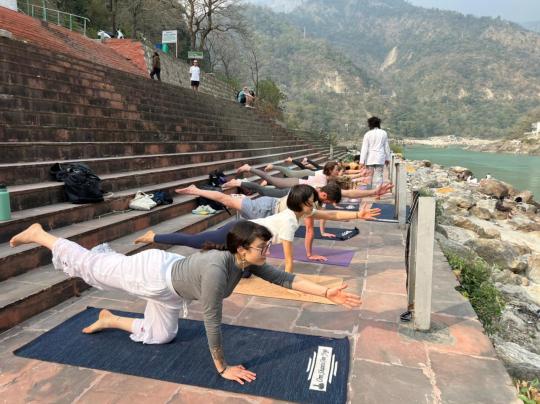
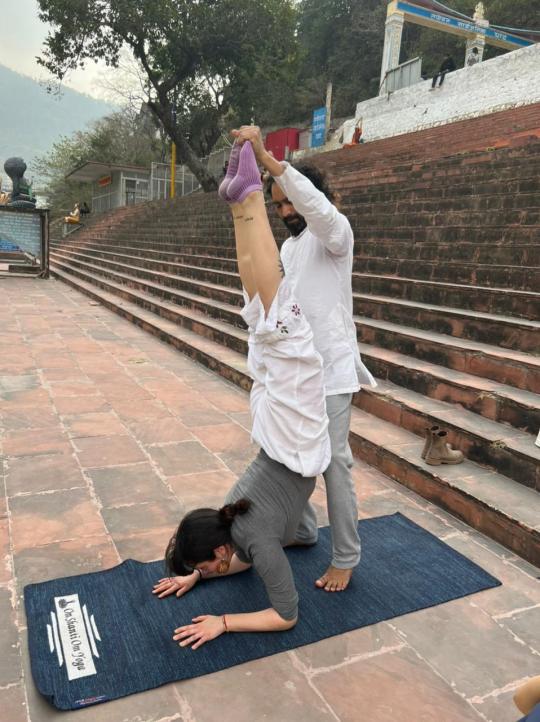


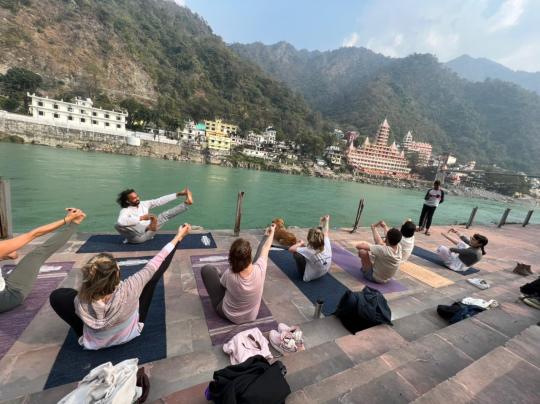
#yoga#yoga teacher training#yoga ttc in rishikesh#hatha yoga#yoga philosophy#yoga studio#yoga center#yoga retreats#yoga class#yoga teacher
2 notes
·
View notes
Text
The Best Yoga Teacher Training in Rishikesh India 2024
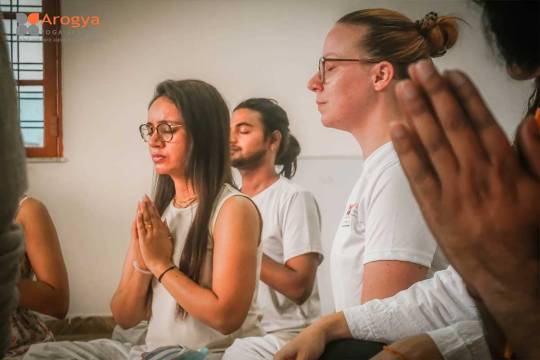

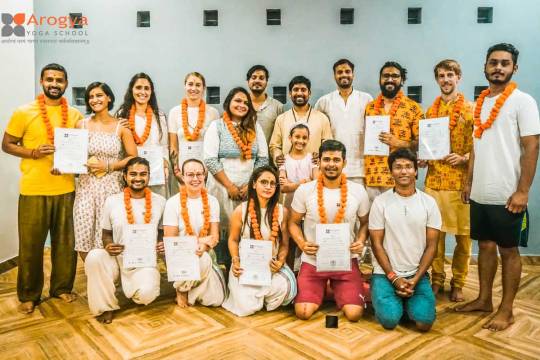

Hatha and Ashtanga Yoga Teacher Training Course at Arogya Yoga School, Rishikesh. Certified by Yoga Alliance USA
If you are looking to bring a change into your life by learning yoga for self-rejuvenation or transfer the benefits to others, by getting a professional certificate and expertise, then Arogya Yoga School is the perfect fit for you.
✅200 Hour Yoga Teacher Training in Rishikesh ➤Just 700 USD With Food and Accommodation.
🗓️ 02 To 25 Oct 2023 : Book Now
🗓️ 02 To 25 Nov 2023 : Book Now
🗓️ 02 To 25 Dec 2023 : Book Now
🗓️ 02 To 25 Jan 2024 : Book Now
More Details: https://www.arogyayogaschool.com/
Call/ Whats App: +91-8630677119
Highlights
Morning and evening yoga class
One special session of Ayurveda
One Free sound healing session.
Daily fresh and healthy organic vegetarian/vegan/gluten-free meals
Daily mantra chanting, asana, yoga anatomy, and yoga philosophy
Eligible to register with Yoga Alliance upon completion
Free Yoga Manual Book.
24 nights' accommodation with 3 meals daily
Course objectives
Develop your personal daily practice
One Sound Healing Session.
Develop and practice daily pranayama, Kriyas, Mudras, and meditation
Learn about the skeletal and muscular systems and how this affects your practice and teaching
Study the Patanjali's Yoga Sutras and learn how to incorporate them into your daily practice and life
Learn how to structure a class and then incorporate all these components into designing your own class
Learn to teach this class to your peers in a small group environment and then you will teach this class to your peers as your assessment
Included excursions
You will enjoy weekend excursions on Saturday evenings and Sundays, to make the most of your time off classes.
What's included
24 nights' accommodation
Daily 3 meals nutritious vegetarian meals and herbal tea
Weekend excursions
Course materials will be provided (notebooks, yoga mat, cleansing kit)
1 sound healing session
Outdoor yoga session
1 sightseeing tour
Kirtan
Certificate of completion
Practice teaching, learn how to sequence your first yoga class and teaching tools
Herbal teas
Excursions on Sunday
Yoga Teacher Training Arogya manual
✅300 Hour Yoga Teacher Training in Rishikesh ➤Just 999 USD
🗓️ 02 To 28 Oct 2023 : Book Now
🗓️ 02 To 28 Nov 2023 : Book Now
🗓️ 02 To 28 Dec 2023 : Book Now
🗓️ 02 To 28 Jan 2024 : Book Now
#yoga#education#igyoga#yogaeverywhere#yogalove#home & lifestyle#yogainspiration#yogateacher#yogacourses#yoga in rishikesh#yoga courses in india#ashtanga yoga#hatha yoga teacher training in rishikesh#health is wealth
4 notes
·
View notes
Text
What is the most effective way of meditation for beginners according to Hinduism?
Although meditation is the foundation of Hindu spiritual practice it has been totally neglected and there are very few acharyas and guru that actually focus on teaching this practice. But it is our great good fortune that the Buddhists have preserved and technique and actively propagate it. So for beginners I suggest you join a vipassana mediation group in your local city to learn the basics.
The key text which deals with meditation is the Yoga sūtra of Maharishi Patanjali. Meditation is also addressed in the Gītā in the chapter entitled Dhyāna Yoga. What is termed “meditation’ in English has four stages, the preliminary of course being sitting in a comfortable posture (āsana) and practicing synchronicity of breathing (praṇāyāma).
pratyahāra — sitting in a comfortable posture with the spine erect one begins to withdraw one’s attention from external stimuli while paying attention the breath. Every time the mind wander you bring it back to the breath. One can also use a mantra like so-ham or even om-shanti to regulate the breath. The breath is connected to the mind so to quieten the mind one needs to regulate the breath.
dhāraṇa — means a focusing of the now quiet mind by using a mantra or any other device to center the thoughts upon. In Tantra the recommended technique is to use the images of the gods and goddesses or an image of one’s tutelary deity (iṣṭha-devatā) visualized within the heart or above the head. Christians can use a pleasant image of peaceful Jesus — remember what you meditate upon you become, so the purpose is to achieve an identification with the deity. Using the image of a wrathful or suffering deity has its consequences unless under the direction of a competent guide. Muslims can use the image of throne (arsh) while reciting the names of Allah.
These two stages are the active part of meditation the 3rd one is passive. i.e. it happens
dhyāna — when one become completely focused on the whole process like a sportsman or a cyclist or squash player when one becomes merged with the flow and is unaware of anything else - sportsmen call it “being in the zone”.
samādhi — means total absorption and this comes only after a very very long time of regular practice of the first three stages - it can take many years to achieve.
#bhagavatam#astrology numerology vedicastrology#vedic astrology#vedas#vedic jyotish online#vedic astro observations#astrology#krishna#lordkrishna#bhagwan#bhagwatgeeta#bhagavad gita#harekrishna#hare krishna#bhagwad gita#lordram#lordvishnu#lordshiva#lord krishna#hare krsna#krsna#yoga#yogainspiration#yogaeveryday#spiritual development#spiritualawakening#spiritual enlightment#spiritual awakening#spirituality#enlightenedones
11 notes
·
View notes